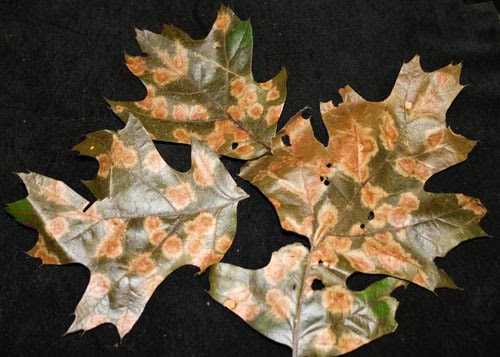CALL TO MEET WITH AN ARBORIST
704.525.3066 Charlotte
828.231.6008 Asheville
704.892.8927 Lake Norman
Fungal Leaf Spot
What Is It?
Leaf spot, caused by different species of fungi, is a widespread and destructive disease. If conditions are favorable, leaf spot can occur on many varieties of trees and shrubs in our region. This disease is most damaging to plants in the landscape and nurseries during periods of cool, wet weather and when active growth is occurring. Tiny, circular spots on both the upper and lower surfaces of young expanding leaves are the first symptoms of leaf spot. Numerous small spots may merge into large blotches on heavily diseased leaves. Leaf spots on mature leaves have ash brown to light gray centers with a distinctive deep red or brownish border. Tiny black specks can often be observed in the center of each leaf spot. Spots similar to those on the leaves can develop on leaf petioles and tender stem growth during prolonged periods of cool, wet weather. Low levels of leaf spot usually cause little more than cosmetic damage but maintain a source of spores for future infections. Severe infections, however, often result in early and heavy leaf drop.


How Does It Survive?
Spots on the leaves and young shoots are important in the survival of leaf spot fungi. Fallen, diseased leaves are less important sources of the fungus. Masses of spores are released during periods of wet weather from the fungal spore producing structures in the center of the spots from late winter through much of the year except during the hot periods of summer. These spores are spread to healthy foliage by a combination of splashing water and wind. New leaf spot symptoms appear within 10-14 days after a wet infection period.
What Can We Do?
Isolated healthy plants or hedges can often remain healthy as the spores are only splashed over short distances. Space plants to improve the air movement around the plants and promote rapid drying of leaf surfaces. If it is necessary to irrigate the plants, do not wet the foliage or irrigate in midday to reduce the period of time foliage remains wet. If possible, remove fallen diseased leaves. Good sanitation and sterilization are critical to slowing transmission. Sterilize tools to prevent infection before pruning each plant. Also, reduce pruning during the summer, which promotes continual new growth. Severely defoliated plants may need to be pruned heavily to have a small, easier to spray plant, to reduce the source of spores and improve air movement. It may be necessary to remove severely diseased plants and replace them with another plant species that is not susceptible to leaf spot. This disease is very difficult to control after plants are severely infected. During extended cool, wet periods, protective sprays may be necessary. Where leaf spot is a problem, anti-fungal applications should begin as new growth starts in the spring with additional sprays throughout the growing season. Fungicide applications should not be necessary during hot, dry periods. It may also be helpful to make 3-4 applications from mid-October to late November if wet weather prevails.

GET LIVE UPDATES FROM HEARTWOOD TREE
Stay current with the updates, newsletter and our event schedule. We are passionate about increasing awareness about the diminishing canopy coverage of our planet and we’re always staying involved to continue to be a part of the solution.

